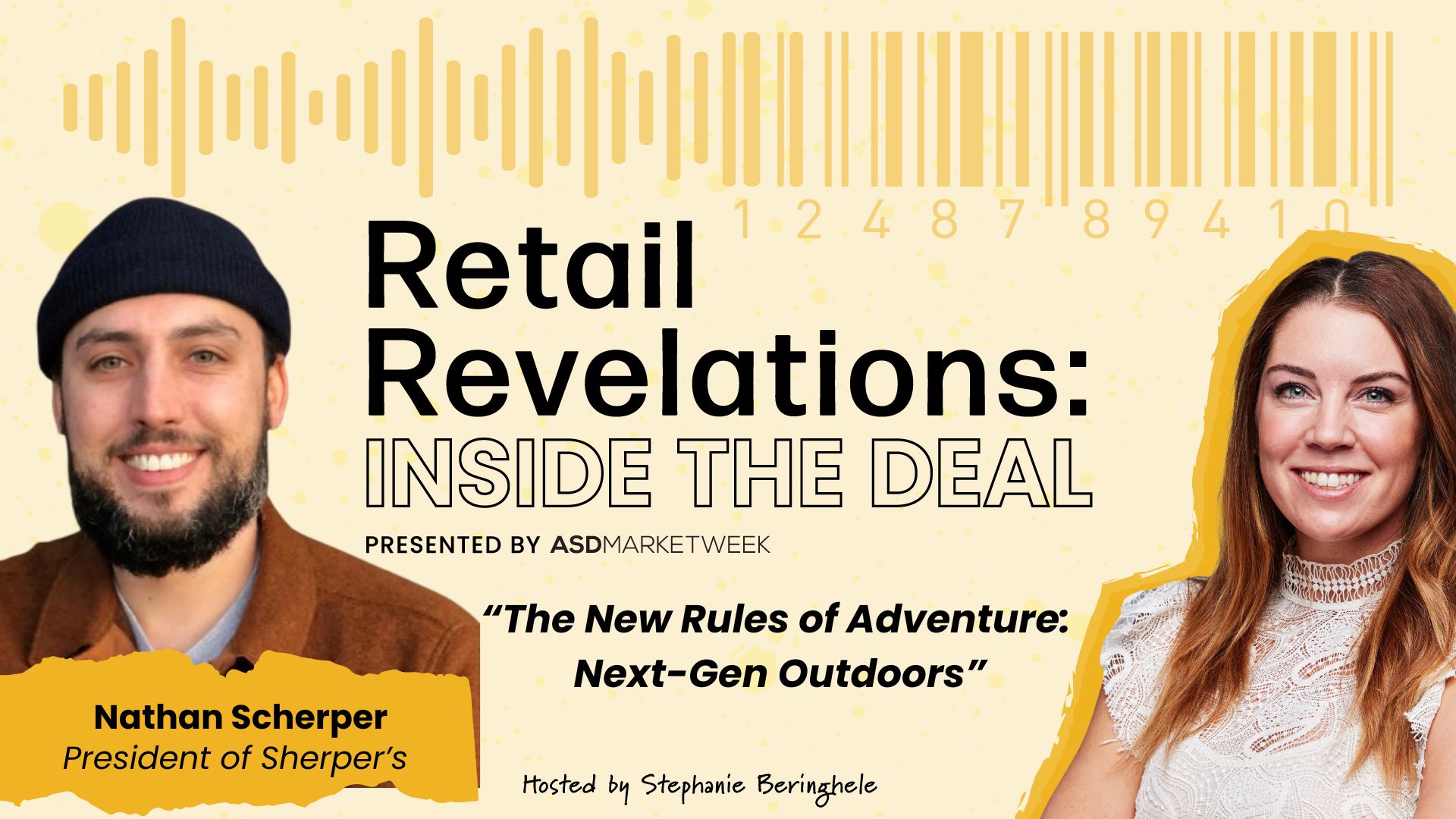Nathan Scherper knows retail. From starting out on the sales floor at Sherper’s (the outdoor retail business that’s been in his family since 1935) at age 12 to working at Abercrombie & Fitch corporate, and ultimately returning to Sherper’s as company president, Nathan brings a unique perspective shaped by hands-on experience and industry insight. In a recent episode of ASD Market Week’s YouTube series Retail Revelations: Inside the Deal, Nathan talked with ASD Market Week’s VIP Attendee Relations Director, Stephanie Beringhele, about building a business rooted in community, embracing tech without losing the human touch, and standing out with storytelling. He even revealed the inside scoop on that missing “C” in the company name.
E-Commerce That Feels Like Home
When Nathan returned to Sherper’s, he set out to modernize the business without sacrificing its personal touch. His first major move? Hiring an e-commerce manager. Fast forward 10 years, and that e-commerce manager is still answering customer calls personally, leveraging knowledge gained from working on-site and a deep appreciation for the business to create a warm, individualized experience with every customer interaction. While enhancing Sherper’s e-commerce offerings opened the doors for nation-wide customer targeting, Nathan quickly realized the greatest opportunity was local: capturing the loyalty of Wisconsin shoppers who already knew and trusted the brand.
COVID-19 accelerated this focus on local service. Sherper’s leaned into services they’d quietly offered for years — like BOPIS (buy online, pick up in store) and curbside delivery. “We’ve done that for 20 years!” Nathan laughs, recalling home deliveries of kayaks within a 25-mile radius. “It’s another 10 minutes out of my day, and the good faith that you can have with that customer and the word of mouth you can get from those customers — big retail isn’t going to do that.” This approach is a powerful reminder for retailers: blending brick-and-mortar strengths with digital convenience isn’t just about tech, it’s about trust. Sherper’s staff, many of whom have been with the company for decades, are “people who are either family or basically family at this point. They care a lot about it, they know who we are and what we stand for and how to portray that to the customer.”
Turning Quirks into Brand Gold
Sherper’s history is woven into its brand, right down to the missing “C” in the store name. The story goes that Nathan’s great-grandfather, Sam, bought everything he needed for the store, saving the sign for last — and then discovering that there wasn’t enough money left for the size of sign necessary to display the entire “Scherper” name, so he dropped the “C.” Nathan has turned this quirk into a retail asset and opportunity to build brand affinity, with “The Lost C,” a discount section in the store. This playful storytelling not only differentiates Sherper’s but also connects with customers hunting for value and authenticity — a trend that’s resonating industry-wide as retailers seek to build loyalty through narrative, not just price.
Merchandising for Every Customer
Nathan’s merchandising philosophy is refreshingly inclusive. “As a retailer, I want to cater to everybody,” he said. Instead of targeting a narrow demographic, he focuses on understanding his local customer base, offering options at every price point. He describes his product mix as “organized chaos,” balancing the art and science of assortment planning. That approach is echoed in his buying trips to ASD Market Week:
“The breadth of stuff was amazing … I think the eclectic nature of it was the best part. To be able to go into one place and say, ‘oh I’ve never thought about carrying that in the store, I think that would do well.”
This openness to new ideas and new finds — like stocking synthetic Davy Crockett-esque racoon hats, a nod to a local high school mascot — keeps Sherper’s relevant and hyper-local.
Trends for 2026 and Beyond
Looking ahead, Nathan is optimistic about the future of retail, even as the industry navigates challenges like tariffs and supply chain uncertainty. He focuses on what he can control — stocking up on products from impacted regions and seeking out closeout deals to ensure Sherper’s is well-positioned for the near term. Rather than making rash decisions, Nathan advocates for a flexible, proactive approach, ready to adapt as market conditions evolve.
Reselling and recommerce are also top of mind, especially as younger shoppers embrace these models. While this shift can create some tension with vendor partners, Nathan sees it as an opportunity for constructive conversations about how to expand product offerings that complement reused goods and meet emerging consumer preferences. He also anticipates a rise in “merchant-first leadership” in retail, where leaders like chief merchandising officers and chief product officers combine technical analysis with a holistic view of their product mix and brand. As AI and analytics play a bigger role in assortment planning, the human touch — balancing data with intuition — remains essential.
In the End, Authenticity Wins
Sherper’s story is proof that retail success isn’t about chasing every trend — it’s about knowing your strengths and staying true to your story. As Nathan puts it, “If we see something and we’re like ‘that’s really going to resonate with our customer,’ there’s no ‘that doesn’t fit in our store’ or ‘that doesn’t make sense for our store.’ If customers will see value in it, we should put it in the store.”
For retail professionals navigating 2025 and beyond, Sherper’s approach offers a blueprint: embrace your roots, innovate with intention, and never underestimate the power of a good story.Watch the full interview with Nathan Scherper on ASD Market Week’s Retail Revelations: Inside the Deal for even more actionable insights.
Ready to discover new products and find your own inspiration? Register now for ASD Market Week, Aug. 3-6, 2025 in Las Vegas.








0 Comments